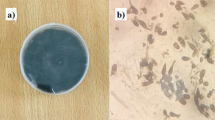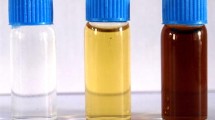Abstract
Silver nanoparticles (AgNPs) were green synthesized using leaf extract of the leaf blight disease (Rhizoctonia solani) susceptible red amaranthus (Amaranthus tricolor L.) and the disease-resistant green (A. dubius) and the wild amaranthus (A. viridis) genotypes, physically characterized, and assessed for their anti-fungal effects against R. solani. The green synthesized nanostructures showed an absorption maximum typical of silver nanoparticles in spectroscopy, and face-centered cubic structures in X-ray diffraction. Field Emission Scanning Electron Microscopic analysis and High-Resolution Transmission Electron Microscopy revealed the size range to be 35–45 nm for all the samples. In vitro mycelial growth inhibition of the pathogen occurred with 500 and 750 ppm concentrations of the nanoparticles in a poisoned-food assay. Further, detached leaves of red amaranthus variety were sprayed with the nanoparticles, and then challenged with the pathogen. There was significant difference in lesion development on leaves sprayed with Ad-AgNPs and Av-AgNPs compared to those treated with At-AgNPs. In the in vivo assay, challenging with the pathogen after spraying the foliage of the leaf blight susceptible red amaranthus variety with Ad-AgNPs at 750 ppm concentration recorded the lowest disease index (7.40) followed by that received Av-AgNPs spray at the same concentration (17.69), five days after inoculation. At-AgNPs treated plants had a disease index of 49.38. Our findings suggest that application of AgNPs green synthesized with leaf extract of disease-resistant genotypes of amaranthus effectively suppressed leaf blight disease incidence in a susceptible amaranthus genotype. To our knowledge, this is the first report on the improved plant pathogen-suppressive activity of any metal nanoparticle when biogenically synthesized using extracts from a disease-resistant plant genotype.







Similar content being viewed by others
Data Availability
Data will be made available on request.
References
Abou El-Nour KM, Eftaiha AA, Al-Warthan A, Ammar RA (2010) Synthesis and applications of silver nanoparticles. Arab J Chem 3:135–140
Afreen A, Ahmed R, Mehboob S, Tariq M, Alghamdi HA, Zahid AA, Hasan A (2020) Phytochemical-assisted biosynthesis of silver nanoparticles from Ajuga bracteosa for biomedical applications. Mater Res Express 7:075404
Ahmad H, Venugopal K, Rajagopal K, De Britto S, Nandini B, Pushpalatha HG, Jogaiah S (2020) Green synthesis and characterization of zinc oxide nanoparticles using Eucalyptus globules and their fungicidal ability against pathogenic fungi of apple orchards. Biomolecules 10:425
Alex S, Rani PMR, Soni KB, Nair DS, Reghunath BR (2012) Biosynthesis of silver nanoparticles with antibacterial activity using leaf extract of Michelia champaca. J Plant Sci Res 28:121–126
Al-Othman MR, Abd El-Aziz ARM, Mahmoud MA, Eifan SA, El-Shikh MS, Majrashi M (2014) Application of silver nanoparticles as anti-fungal and antiaflatoxin B1 produced by Aspergillus flavus. Dig J Nanomater Bios 9:151–157
Al-Otibi F, Alkhudhair SK, Alharbi RI, Al-Askar AA, Aljowaie RM, Al-Shehri S (2021) The anti-microbial activities of silver nanoparticles from aqueous extract of grape seeds against pathogenic bacteria and fungi. Molecules 26:6081
Asimuddin M, Shaik MR, Adil SF, Siddiqui MRH, Alwarthan A, Jamil K, Khan M (2020) Azadirachta indica based biosynthesis of silver nanoparticles and evaluation of their antibacterial and cytotoxic effects. J King Saud Univ Sci 32:648–656
Bahrami-Teimoori B, Nikparast Y, Hojatianfar M, Akhlaghi M, Ghorbani R, Pourianfar HR (2017) Characterisation and anti-fungal activity of silver nanoparticles biologically synthesized by Amaranthus retroflexus leaf extract. J Exp Nanosci 12:129–139
Bawazeer S, Rauf A, Shah SUA, Shawky AM, Al-Awthan YS, Bahattab OS, El-Esawi MA (2021) Green synthesis of silver nanoparticles using Tropaeolum majus: phytochemical screening and antibacterial studies. Green Process Synth 10:85–94
Bijula BL, Alex S, Soni KB, Anith KN, Joy M, Nair DS, Beena R, Benny A (2022) Algicidal effects of green synthesized silver nanoparticles using Tinospora cordifolia on Chlamydomonas reinhardtii. J Pure Appl Microbiol 16:1122–1129
Castillo-Henríquez L, Alfaro-Aguilar K, Ugalde-Alvarez J, Vega-Fernandez L, Montes de Oca-Vasquez G, Vega-Baudrit JR (2020) Green synthesis of gold and silver nanoparticles from plant extracts and their possible applications as anti-microbial agents in the agricultural area. Nanomaterials 10:1763
Celine VA, Girija VK, Sreelathakumary I, Vahab MA (2013) Selection of amaranth genotypes for resistance to Rhizoctonia solani. Int J Veg Sci 19:157–163
Dikshit PK, Kumar J, Das AK, Sadhu S, Sharma S, Singh S, Kim BS (2021) Green synthesis of metallic nanoparticles: applications and limitations. Catalysts 11:902
Elmer W, White JC (2018) The future of nanotechnology in plant pathology. Annu Rev Phytopathol 56:111–133
Fatimah I, Aftrid ZHVI (2019) Characteristics and antibacterial activity of green synthesized silver nanoparticles using red spinach (Amaranthus tricolor L) leaf extract. Green Chem Lett Rev 12:25–30
Flores-Lopez LZ, Espinoza-Gomez H, Somanathan RM (2019) Silver nanoparticles: electron transfer, reactive oxygen species, oxidative stress, beneficial and toxicological effects: mini review. J Appl Toxicol 39:16–26
Ghazy NA, Abd El-Hafez OA, El-Bakery AM, El-Geddawy DI (2021) Impact of silver nanoparticles and two biological treatments to control soft rot disease in sugar beet (Beta vulgaris L). Egypt J Biol Pest Control 31:1–12
Gokulapalan C, Reghunath P, Celine VA, Nair SR (1999) Managing leaf blight on amaranth. Indian J Hortic 44:33–33
Gokulapalan C, Kamala N, Umamaheswaran K (2000) Foliar blight of Amaranthus caused by Rhizoctonia solani Kuhn. J Mycol Plant Pathol 30:239–241
Gopinath PP, Parsad R, Joseph B, Adarsh VS (2021) GrapesAgri1: collection of shiny apps for data analysis in agriculture. J Open Source Softw 6:3437
Iravani S, Korbekandi H, Mirmohammadi SV, Zolfaghari B (2014) Synthesis of silver nanoparticles: chemical, physical and biological methods. Res Pharm Sci 9:385
Kaur S, Sharma K, Singh R, Kumar N (2022) Advancement in crops and agriculture by nanomaterials. In: Thakur A, Thakur P, Khurana SP (eds) Synthesis and applications of nanoparticles. Springer, Singapore. https://doi.org/10.1007/978-981-16-6819-7_14
Khan MR, Rizvi TF (2014) Nanotechnology: scope and application in plant disease management. Plant Pathol J 13:214–231
Khan I, Saeed K, Khan I (2019) Nanoparticles: Properties, applications and toxicities. Arab J Chem 12:908–931
Kolya H, Maiti P, Pandey A, Tripathy T (2015) Green synthesis of silver nanoparticles with anti-microbial and azo dye (Congo red) degradation properties using Amaranthus gangeticus Linn leaf extract. J Anal Sci Technol 6:1–7
Koyyati R, Nagati V, Nalvothula R, Merugu R, Kudle KR, Marx P, Padigya PRM (2014) Antibacterial activity of silver nanoparticles synthesized using Amaranthus viridis twig extract. Int J Res Pharm Sci 5:32–39
Kumar JA, Krithiga T, Manigandan S, Sathish S, Renita AA, Prakash P, Crispin S (2021) A focus to green synthesis of metal/metal-based oxide nanoparticles: various mechanisms and applications towards ecological approach. J Clean Prod 324:129198
Meng Y, Zhang H, Hu N, Zhang B, Qiu Z, Hu J, Xu X (2021) Construction of silver nanoparticles by the triple helical polysaccharide from black fungus and the antibacterial activities. Int J Biol Macromol 182:1170–1178
Mikhailova EO (2020) Silver nanoparticles: mechanism of action and probable bio-application. J Funct Biomater 11:84
Mishra AK, Tiwari KN, Saini R, Kumar P, Mishra SK, Yadav VB, Nath G (2020) Green synthesis of silver nanoparticles from leaf extract of Nyctanthes arbor-tristis L and assessment of its antioxidant, anti-microbial response. J Inorg Organomet Polym 30:2266–2278
Nair CB, Anith KN (2009) Efficacy of acibenzolar-S-methyl and rhizobacteria for the management of foliar blight disease of amaranth. J Trop Agric 47:43–47
Nayar K, Gokulapalan C, Nair MC (1996) A new foliar blight of amaranthus caused by Rhizoctonia solani. Indian Pyhtopathol 49:406–407
Panth M, Hassler SC, Baysal-Gurel F (2020) Methods for management of soilborne diseases in crop production. Agriculture 10:16
Preenanka R, Sebastian D (2022) Characterization of green synthesized antibacterial silver nanoparticles from Amaranthus spinosus L extract. BioNanoSci 12:502–511
Qian Y, Yu H, He D, Yang H, Wang W, Wan X, Wang L (2013) Biosynthesis of silver nanoparticles by the endophytic fungus Epicoccum nigrum and their activity against pathogenic fungi. Bioprocess Biosyst Eng 36:1613–1619
Roy A, Bulut O, Some S, Mandal AK, Yilmaz MD (2019) Green synthesis of silver nanoparticles: biomolecule-nanoparticle organizations targeting anti-microbial activity. RSC Adv 9:2673–2702
Sharma D, Kanchi S, Bisetty K (2019) Biogenic synthesis of nanoparticles: a review. Arab J Chem 12:3576–3600
Siddhartha VA, Bashyal BM, Gogoi R, Kumar R (2020) New nano-fungicides for the management of sheath blight disease (Rhizoctonia solani) in rice. Int J Pest Manag 68:217–226
Sigamoney M, Shaik S, Govender P, Krishna SBN (2016) African leafy vegetables as bio-factories for silver nanoparticles: a case study on Amaranthus dubius C Mart. Ex Thell S Afr J Bot 103:230–240
Singh R, Patade VY, Sanchita Singh A (2021) Anti-microbial potential of silver nanoparticles biosynthesized using aerial yam bulbils for control of selected phytopathogens. Arch Phytopathol Plant Prot 54:2275–2293
Valsalam S, Agastian P, Arasu MV, Al-Dhabi NA, Ghilan AKM, Kaviyarasu K, Arokiyaraj S (2019) Rapid biosynthesis and characterization of silver nanoparticles from the leaf extract of Tropaeolum majus L and its enhanced in-vitro antibacterial, anti-fungal, antioxidant and anticancer properties. J Photochem Photobiol B Biol 191:65–74
Wang C, Singh P, Kim YJ, Mathiyalagan R, Myagmarjav D, Wang D, Yang DC (2016) Characterization and anti-microbial application of biosynthesized gold and silver nanoparticles by using Microbacterium resistens. Artif Cells Nanomed Biotechnol 44:1714–1721
Wei S, Wang Y, Tang Z (2021) A novel green synthesis of silver nanoparticles by the residues of Chinese herbal medicine and their biological activities. RSC Adv 11:1411–1419
Wen H, Shi H, Jiang N, Qiu J, Lin F, Kou Y (2023) Anti-fungal mechanisms of silver nanoparticles on mycotoxin producing rice false smut fungus. Iscience 26:105763
Worrall EA, Hamid A, Mody KT, Mitter N, Pappu HR (2018) Nanotechnology for plant disease management. Agronomy 8:285
Wypij M, Jędrzejewski T, Trzcinska-Wencel J, Ostrowski M, Rai M, Golinska P (2021) Green synthesized silver nanoparticles: antibacterial and anticancer activities, biocompatibility, and analyses of surface-attached proteins. Front Microbiol 12:632505
Yashaswini MS, Nysanth NS, Anith KN (2021) Endospore-forming bacterial endophytes from Amaranthus spp. improve plant growth and suppress leaf blight (Rhizoctonia solani Kühn) disease of Amaranthus tricolor L. Rhizosphere 19:100387
Yashaswini MS, Nysanth NS, Gopinath PP, Anith KN (2022) Endospore-forming phyllosphere bacteria from Amaranthus spp. suppress leaf blight (Rhizoctonia solani Kuhn) disease of Amaranthus tricolor L. J Trop Agric 60:95–108
Zhou H, Yuan X, Zhou H, Shen H, Ma L, Sun L, Fang G, Sun H (2022) Surveillance of pine wilt disease by high resolution satellite. J For Res 33:1401–1408
Acknowledgements
The authors are grateful to the Kerala Agricultural University for the facilities provided for undertaking the study. The help extended by Department of Science and Technology-Sophisticated Analytical Instumentation Facility, Mahatma Gandhi University, Kottayam, Kerala in physical characterization of the nanoparticles is gratefully acknowledged.
Author information
Authors and Affiliations
Contributions
SD: investigation, visualization, writing original draft. ARA: investigation, writing original draft. SV: investigation. SGJ: resources, visualization. PAD: investigation. ASRD: investigation. SST: resources. EMV: resources, visualization. PPG: formal analysis. KNA: conceptualization, methodology, writing—review and editing, supervision.
Corresponding author
Ethics declarations
Conflict of interest
The authors declare that they have no known competing financial interests or personal relationships that could have appeared to influence the work reported in this paper.
Rights and permissions
Springer Nature or its licensor (e.g. a society or other partner) holds exclusive rights to this article under a publishing agreement with the author(s) or other rightsholder(s); author self-archiving of the accepted manuscript version of this article is solely governed by the terms of such publishing agreement and applicable law.
About this article
Cite this article
Divya, S., Anusree, A.R., Vigi, S. et al. Silver nanoparticles green synthesized with leaf extract of disease-resistant amaranthus genotypes effectively suppress leaf blight (Rhizoctonia solani Kühn) disease in a susceptible red amaranthus cultivar. 3 Biotech 13, 196 (2023). https://doi.org/10.1007/s13205-023-03614-y
Received:
Accepted:
Published:
DOI: https://doi.org/10.1007/s13205-023-03614-y




